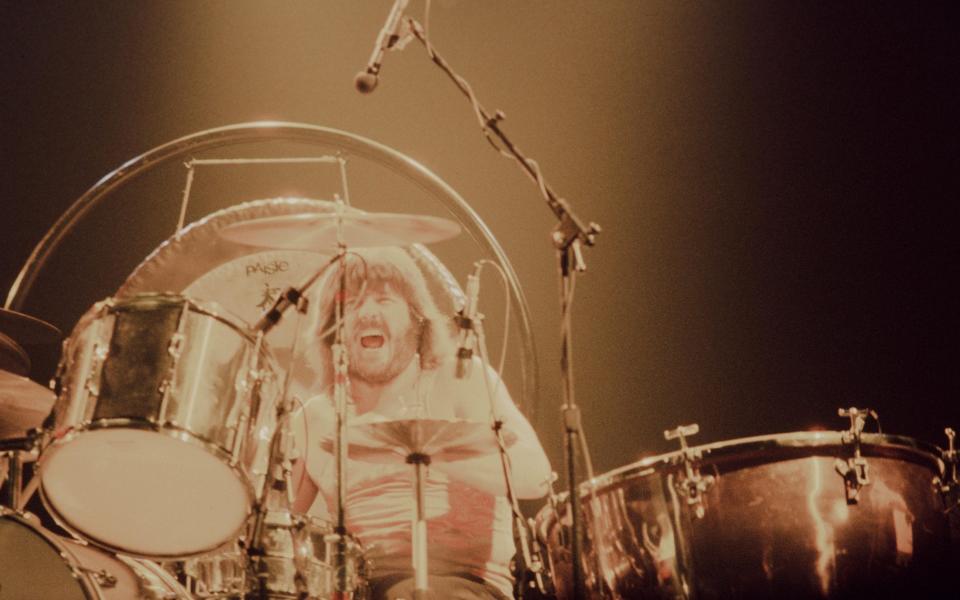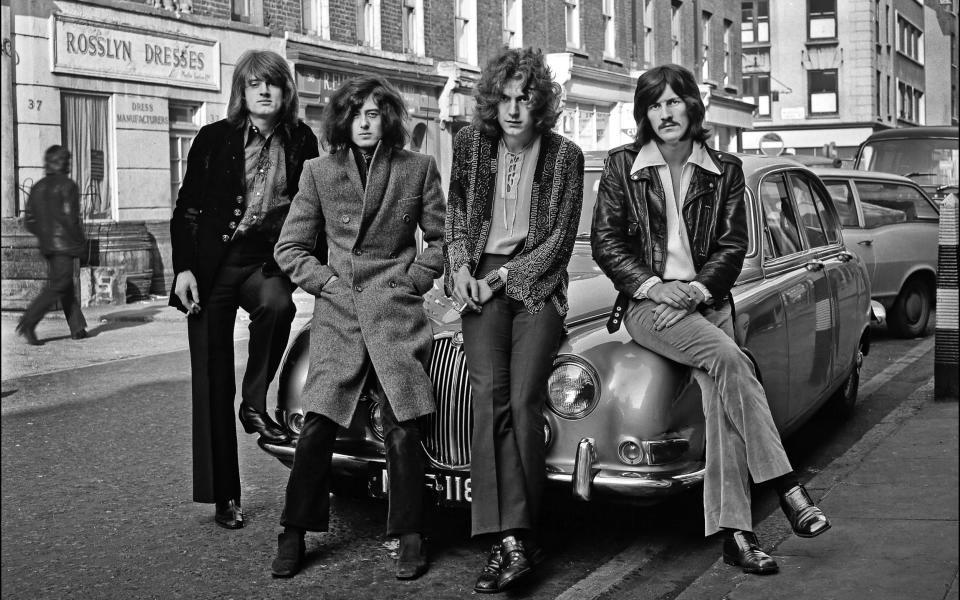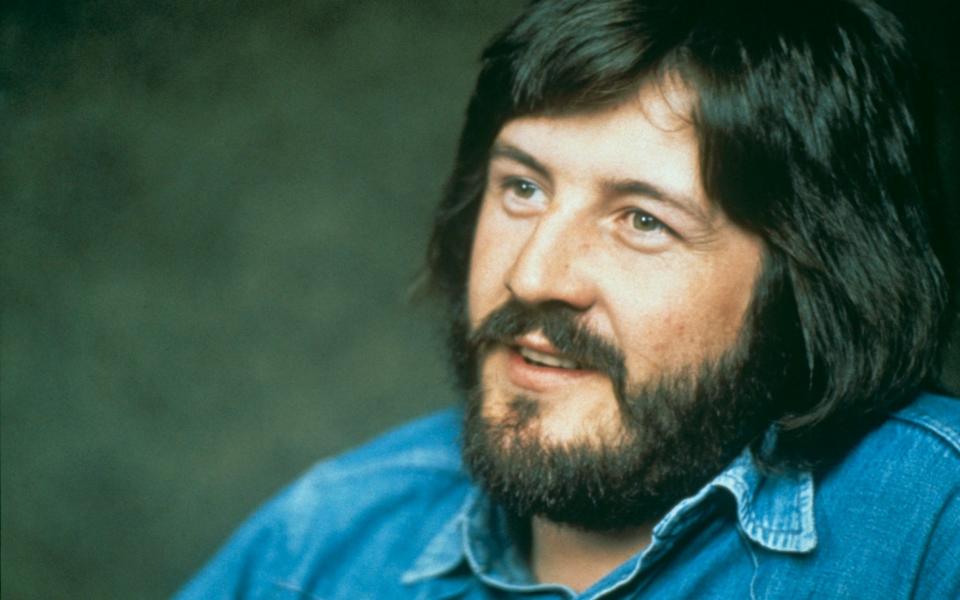Led Zeppelin's 'wounded pit bull': the terrifying, tragic talent of John Bonham

Late in the evening of Monday July 7 1980, the final chords of Whole Lotta Love rang out through the 6,000-capacity Eissporthalle ice rink in Berlin, West Germany. The four members of Led Zeppelin left the stage broadly happy that the last performance of their 14-date European tour – their first in seven years – had gone well. But what they couldn’t have known was that the Berlin date would be their last ever show together due to the death of hard-living drummer John ‘Bonzo’ Bonham just 11 weeks later.
Bonham was found dead on the afternoon of September 25 in a guest room at bandmate Jimmy Page’s house in Windsor after a monumental drinking binge. He’d consumed an estimated 40 shots of vodka the day before as the band were rehearsing for what was meant to be a comeback tour of North America. Bonham had choked on his own vomit. He was 32.
Forty years on from their final concert, Led Zeppelin are still revered as one of the finest hard rock bands ever to have played. But the story of Bonham’s demise is a salutary lesson in the pitfalls of fame, fortune and life on the road. Although the band’s glory days were arguably over when he died, the tragedy brought the shutters down on a group still eager to prove they had a third act in them. His death was “one of the most flattening, heartbreaking parts of my life”, singer Robert Plant said two years later.
Apart from a few reunion shows, such as at 1985’s Live Aid and their one-off 2007 concert at London’s O2, the Led Zep project was over. Yet Bonham’s legacy lives on. He remains one of the most technically gifted, hardest-hitting and celebrated drummers in rock history, constantly vying for the top spot in ‘best ever drummer’ polls with jazz supremo Buddy Rich. Not bad for a carpenter’s son from the Midlands who, in the words of unofficial band biographer Stephen Davis, grew up “hammering things”.
In the months before Bonzo’s death, Led Zeppelin were a band refinding their mojo. A series of setbacks in the late-1970s had knocked them off course. Plant had been derailed by an accident – a 1975 car crash on Rhodes had left him struggling to walk – and an unimaginable tragedy – in 1977 his five year-old son Karac died from a stomach infection. Musically, punk had come along and altered the landscape (although guitarist Jimmy Page has often said that punk’s raw spirit reminded them of their former selves).
Their most recent two albums, Presence and In Through The Out Door, had had their moments but lacked the sheer power of the band’s late-60s and early-70s output of Led Zeppelin I to IV, Houses of the Holy and Physical Graffiti. However a pair of vast outdoor concerts at Knebworth in 1979 had re-energised Zeppelin (official figures put attendance at each show at 100,000, although the band put the figure at four times that).
As soon as 1980’s deliberately modest Tour Over Europe wrapped in Berlin, they were gearing up for their first North American tour since 1977, due to start that October in Montreal. With the new decade came hopes of a late-career reboot.
But underlying issues remained. Lifestyles in the Zeppelin camp had never lent themselves to longevity. This was particularly apt for Bonham. When off the road he was a down-to-earth family man who loved nothing more than pootling about his Worcestershire farm on his tractor. But when touring, Bonzo – the rich, cosseted and bored rock star miles from home and his beloved Massey Ferguson – would live up to his other nickname of The Beast.
And Zeppelin toured a lot, once carrying out six US tours in the space of 19 months. Bonham’s appetite for excess on the road was as colossal as his drumming. Bonzo’s “way of expressing himself was with his hands and his feet”, according to music journalist Mick Wall. This went for rearranging hotel rooms as well as whacking his drum kit.
When drunk, he’d “growl like some dangerous and wounded pit bull”, wrote Davis in unauthorised band biography Hammer of the Gods. In one sense his behaviour can be easily explained: this was a man who once had to quit smoking in order to pay the rent and now he had it all. But like his friend and fellow drummer Keith Moon, who died in 1978, Bonham was a magnet for mayhem.

Stories about his rock ‘n’ roll behaviour are legion, and range from the charming to the downright scary. On his 25th birthday party during the band’s 1973 US tour, Bonham had a cake fight with George Harrison and threw the entire party, including Harrison’s wife Pattie Boyd, into the swimming pool (with the exception of the band’s hugely fat manager Peter Grant, who was too heavy to lift).
In a Monte Carlo nightclub stuffed with mafia-types in 1976, Bonham got drunk and pulled a gas gun on the crowd from a holster concealed beneath his – what else? – crisp white suit. Only a diversionary fist fight started by his entourage prevented the situation from escalating (although they were all detained by the police). And in 1977 Bonham was arrested in Oakland along with Grant and others after a brutally violent attack on members of promoter Bill Graham’s team.
By the late 1970s, the partying had become darker. According to Mick Wall in his Dead Rock Stars podcast, Bonzo used heroin. This had curtailed his drinking for a while. But when he went on a drug called Motival to deal with his heroin use, the drinking started again. On the 1980 European tour, Bonham was “at his heaviest [and] fully bearded”, writes Davis (although he “played in top form when he was feeling well”).
At a show in Nuremberg that June, Bonham fell off his drum stool after third song Black Dog. Exhaustion and food poisoning were cited as reasons. However, fans who were there suggest otherwise on online forums. “In hindsight it was obvious he was tanked,” writes Joe Allen. Meanwhile Hey Moe remembers: “We could all tell he was drunk the minute he took stage [sic]. He knocked over the same cymbal twice.” (One fan, however, claims an overdose of bananas was to blame.)

The events surrounding Bonham’s death are well documented. On 24 September 1980, the drummer was picked up from his farm near the Worcestershire village of Cutnall Green by Rex King, a loyal member of the Zeppelin entourage, and driven to Page’s house in Windsor for rehearsals for the North American tour. The story goes that Bonham insisted they stop in a pub on the way down, where he drank four quadruple vodkas with orange juice and ate “a couple of ham rolls”, according to Davis.
The drinking continued throughout the rehearsal at Page’s house (a beautiful former mill the guitarist had bought from actor Michael Caine). When Bonzo fell asleep on a sofa that night he was carried up to bed by either his drum tech Mick Hinton or Page’s assistant Rick Hobbs (accounts vary). He was laid on his side.
When Bonham failed to appear the next afternoon, tour manager Benji LeFevre and Zeppelin bass player John Paul Jones went to wake him. They found him dead. “It was terrible. Then I had to tell the other two,” Jones has said.
Bonham’s funeral was held on October 10 in the village of Rushock. Interviewed by Q magazine’s Tom Doyle in 2015, Page was still unable to fully express his grief about Bonham’s death, nor the grief they felt for Bonham’s family. It was “out of the question” and “disrespectful” to Bonham’s memory that the band would carry on with a replacement drummer, Page said.
The band made their decision public that December in a statement to the music press. “We wish it to be known that the loss of our dear friend and the deep respect we have for his family, together with the sense of undivided harmony felt by ourselves and our manager, have led us to decide that we could not continue as we were,” the statement said. That week’s issue of Melody Maker also carried news of John Lennon’s murder in New York. It was a dark month for British music.
But Bonham’s drumming will always remain. Forty years on from his last performance with Zeppelin, he is still seen as a trailblazer. A Rolling Stone list in 2016 of the 100 greatest drummers of all time put Bonham at number one. The publication praised his “heavy, lively, virtuosic… artful clobbering”. And a poll of online polls of the best ever drummers puts Bonham consistently in the top three.
Bonham hit hard (often with his bare hands). But he also had swing, influenced as he was by jazz drummers like Gene Krupa and Dave Brubeck’s stickman Joe Morello. It was Krupa who played one of the first ever commercially-recorded drum solos on Benny Goodman’s 1937 track Sing, Sing, Sing, something that undoubtedly influenced Bonham. His drum solo in Moby Dick was a Zeppelin mainstay.
In technical terms Bonham used what are known as ‘triplets’, which were common in jazz but rare in rock before he co-opted them. A triplet essentially subdivides a single beat into three, creating a frenetic and thrilling drum ‘fill’. He was also known for his ferociously speedy kick drumming. So fast was Bonham with his bass drum pedal that listeners assumed he had two bass drums at his feet on Good Times Bad Times, the opening track on Led Zep’s 1969 debut album. In fact he was simply using his one drum very quickly. But he never showboated. Bonham may have played hard and fast but he displayed great control and economy.

Dave Grohl, the Foo Fighters frontman and former Nirvana drummer, is one of only three drummers from the post-1970s era to have made it into the top 30 of Rolling Stone’s best drummer list. He cites Bonham as a key influence. “I spent years in my bathroom – literally fucking years – listening to Bonham’s drums and trying to emulate his swing or his behind-the-beat swagger or his speed or power,” Dave Grohl told the magazine.
Bonzo was always self-deprecating. In a rare interview, he told Melody Maker in 1972 that he “never tried consciously to be one of the best drummers, and I don’t want to be.” Rather, he said that he enjoyed playing to the best of his ability. “I don’t claim to be more exciting than Buddy Rich. But I don’t play what I don’t like. I’m a simple, straight-ahead drummer and I don’t try to pretend to be anything better than I am,” he said. It is fitting that his replacement at Zeppelin’s 2007 reunion was his son Jason, an accomplished sticksman in his own right.
It’s a mark of how revered Bonzo is – and how broadly his drumming chops are appreciated – that his beats have become among the most sampled in hip hop, dance and pop music. His slow but monumental drumming on When The Levee Breaks has been sampled (or replicated) by Eminem on Kim, by the Beastie Boys on Rhymin & Stealin, by Björk on Army of Me and by Neneh Cherry and Michael Stipe on Trout, to name but four of the estimated 400 tracks that have used it. Meanwhile Salt N Pepa’s A Salt With A Deadly Pepa and Fatboy Slim’s Going Out Of My Head used Bonham’s beat from Houses of the Holy track The Crunge. The list goes on and on.
Bonham’s death may have been messy, tragic and woefully premature. But the legend of his drumming will far outlive the legend of his lifestyle. And given the life he led, that is saying something. As The Rolling Stones’ Charlie Watts once put it, “Bonham – you won’t get another one of him.”


